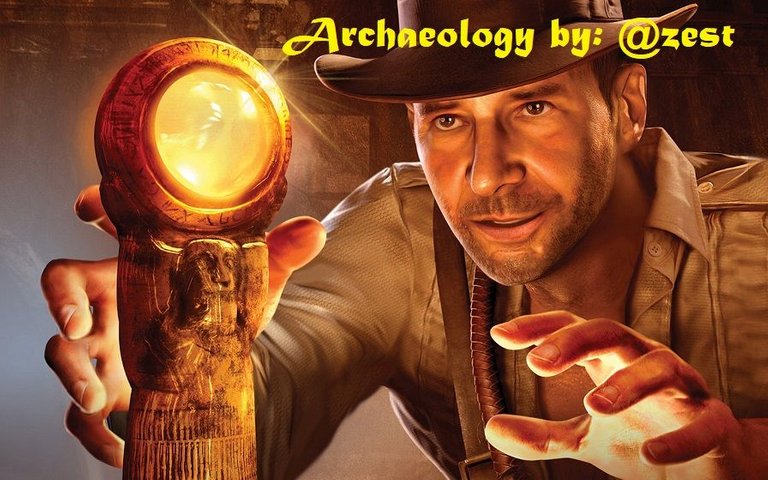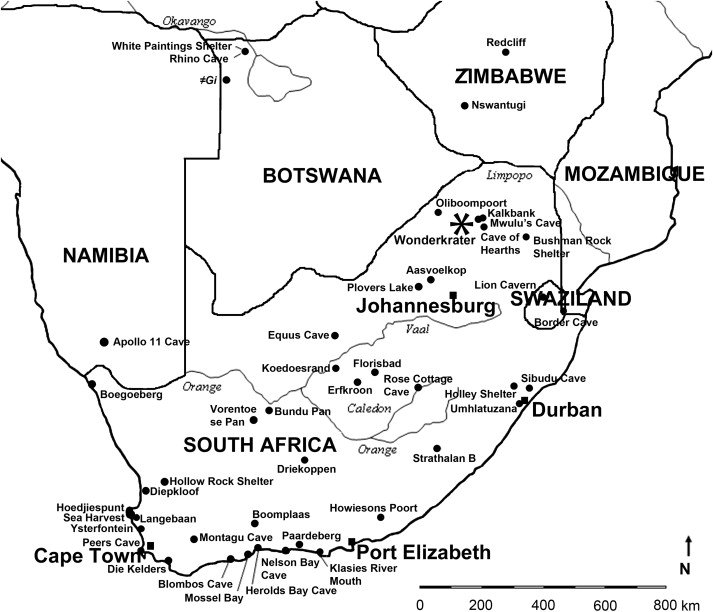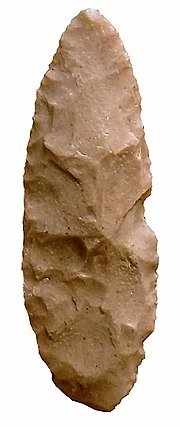
Dear Reader
In this following series of posts we are covering the Later Stone Age of South Africa, I highly encourage you to please read the Introduction, Historical Background, Advances in Later Stone Age, Climatic conditions of the LSA in South Africa, Elements characteristic of the Later Stone Age, The Later Stone Age sequence, Early Later Stone Age: Robberg assemblages, Robberg Subsistence Economy, The Oakhurst, including Albany and Lockshoek non-microlithic assemblages, Wilton assemblages, Hunter-gatherers' way of life:Introduction and Hunter-gatherers' way of life - Ethnographical Evidence posts to this series to bring you update to date with the information and terminology we have covered so far.
Hunter-gatherers' way of life - Archaeological Evidence
- It is difficult to estimate prehistoric territorial demarcation or settlement patterning. Aridity is sometimes used to explain low site numbers (eg between 8500 and 7000 Before Present (BP) in the summer rainfall region) or a break in occupation (eg at Elands Bay Cave from at 7900 to 4800 BP). We have already discussed the absence of early LSA open sites. It is suggested that early Holocene occupation was focussed on large rock shelters, whereas a more ephemeral use is indicated for such localities during the second half of the Holocene, that is, when there is more widespread use of smaller shelters, overhangs and boulders (Wadley 1991).
- Although Holocene faunal analyses indicate the hunting of large to small mammals, there is greater dependence on the hunting of smaller, more territorial animals. The more non-gregarious animals could be hunted at any time of the year by small groups with more fixed territorial boundaries. (The hunting of predominantly large migratory herd animals in the late Pleistocene is associated with large, highly mobile groups with a low population density and an absence of fixed territorial boundaries.)
- In the archaeological record the evidence for subsistence is mainly found in faunal and plant remains which are aslo used to reconstruct the environment and changes that may have occurred during the Holocene. No extinct faunal species are present in Holocene sites. The relative frequencies of larger and smaller mammals indicate a hunting pattern similar to that of present hunter-gatherers. It seems likely that trapping and projectile hunting methods were used and that, in some areas, there was seasonal change in hunting patterns in some areas.
- Bifacial tanged and barbed arrowheads are also found. A time range from about 2000/1500 BP to historical times is suggested for the use of these artefacts (Humphreys 1991).
- Both archaeological and ethnographic evidence is used to suggest that the subsistence strategy of the Wilton in the Cape was, to a large extent, based on gathering of plant foods and shellfish, supplemented by the hunting of mainly small game. The corresponding demographic system was characterised by relatively small groups living in comparatively high density within specific territorial areas. In the western Cape very large quantities of plant food remains occur in assemblages more recent than 2000 BP, whereas far lesser quantities are observed in the preceding period. This may suggest greater reliance on gatherin during the later phase of the LSA, although we need to remember that the lack of preservation may partially account for this apparent pattern. This apparent greater reliance on plant food versus animal food seems to be indicated at a variety of sites in South Africa and could be the focus of future research. The observation of earlier plant-rich levels at Melkhoutboom may, however, indicate that greater dependence on plant food happened much earlier.
- This phenomenon may also correspond to an increase in pastoral activities that placed considerable stress on some previous alternative subsistence methods (eg hunting). In areas which were not optimum habitat for herders, an increase in the sites of foragers/hunter-gatherers may indicate a territoraially stressed people who relied more heavily on more marginal subsistence activities. Ethnographic evidence supports this exploitation of less desirable sources in times of economic stress and unavailabilty of preferred foods. The important fact that emerges is that the hunter-gatherers had to share their territories with pastoralists and agriculturalists after 2000 BP and compete with them for the available resources. This shift in adaptation strategies is reflected in the archaeological record.
- Plant remains are often poorly preserved and, frequently, consist of only the inedible residues of plants collected and processed at the home base. It is therefore almost impossible to estimate the extent of dependence on plant food from the archaeological record alone. The "silence" of the archaeological record means that historic and ethnographic sources on plant usages and the methods of preparation are extremely valuable to archaeologists. Plant remains in archaeological deposits can indicate differences between the range of food and medicinal plants exploited in particular areas. Melkhoutboom Cave has provided some of the most detailed records of preserved plant remains. The Iridaceae family is best represented in the form of residues from underground corms collected during spring and summer.
This evidence corroborates the ethnographic observation of the San as being people who are very much dependent on a preferred set of staple foods that are seasonally abundant. Indeed, this seems to be the trend after ca 5000 BP: many Holocene sequences indicate the increasing use of food species that are predictable and productive and relatively easy to gather, snare or hunt. Although the preservation of plant food remains at living sites is variable, it is becoming increasingly evident that the gathering of plant food was an important economic activity throughout the LSA. (Deacon & Deacon 1999:143)
Historic evidence suggests that the Cape Khoisan relied on underground corms collectively known as "uintjies" such as Hypoxis, Watsonia and Moraea spp. In the western Cape heavier reliance on other species of bulbs indicates regional differences in the preferred set of staples. Information on the plant remains from the dry interior indicates an emphasis on fruits and nuts, although underground plant storage organs represented. Mongongo nuts have been found in deposits of more than 7000 BP in Botswana, and marula nuts have been a favoured food source for thousands of years in the areas where they are common.
- An archaeological study of the LSA people of the Drakensberg area (Opperman 1988) shows that the late Holocene bands of Drakensberg consistently exploited the big game of the region as their primary meat source throughout both the late Pleistocene and Holocene. This contrasts with a dependence on smaller game in other areas. An expanding population rate is reflected in the large number of rock art sites and sites with long cultural sequences in this area. It was also observed that, in this region, they maintained a subsistence system that centred on mountain food resources supplemented in times of scarcity by food resources at the foot of the escarpment. No evidence of large-scale seasonal movement was found, showing the diversity in adaptation strategies in different environments.
- Some sites, such as Nelson Bay Cave, have a record of more or less continuous occupation from at least 19 000 years ago, only showing a hiatus in occupation during the period preceding the Robberg Industry. This may indicate a continuous summer and winter occupation throughout the Holocene, in particularly since the coastline moved closer inland at about 10 000 years BP (Inskeep 1987).
- Marine resources, and to a lesser extent freshwater fish, were a supplementary food source for the Holocene people. Stone-walled fish traps are found both at the coast and inland. In archaeological deposits the remains of freshwater fish, shellfish, marine animals and birds as well as the presence of fish hooks, fish gorges and sinkers indicate that exploiting marine resources was now the norm. In the Drakensberg regions fishing scenes are represented in rock paintings which show people sometimes fishing from boat-like crafts.
Large numbers of shell middens dating to the terminal Pleistocene and Holocene are present along the South Africa coast and probably represent alternative seasonal food resources. Huge mega-middens accumulated in certain areas on the western Cape. Middens in some rock shelters such as Matjes River, some of the Robberg shelters and Elands Bay Cave, have built up to impressive depths of several metres. The shellfish species from middens reflect the species available in the immediate vicinity and also provide information on the environment. The season at which certain shellfish were collected can also be determined: this indicates the season of site occupation.
Shell middens inland and assemblages indicating fish as a source generally date to within the last 2000 years. This implies the use of alternative food sources as a result of the spread of pastoralists and Iron Age people (Deacon & Deacon). Inland shell middens are smaller because freshwater mussels (Unio spp) do not generally occur in large quantities. Inland shell middens in the eastern Cape date to the last 3000 years.
- Various reseachers have observed that the occurrence of seasonally restricted food remains in archaeological deposits could be linked to historically known seasonal movements by the early Khoisan inhabitants of the Cape. Ethnographic evidence also supports this phenomenon.
This model assumes that variability in tool type frequencies of assemblages from roughly the same period reflects the scheduling of activities for different environments and different seasons. In other words, certain tool types were used for some activities in specific areas or during specific seasons.
Parkington (1980) used seasonal indicators such as plants and the mortality ages of dassies (hyraxes) and seals and ecological factors (temperature, rainfall and seasonal changes in shellfish toxicity) to reconstruct the season during which particular sites in the western Cape were occupied. He puts forward a hypothesis of seasonl mobility: LSA people moved to the mountains in Summer to make use of the prolific veld food, this being mainly the underground corms of geophytes of Iridaceae family. In winter they then moved to the sea where coastal resources, and in particular shellfish, were exploited as substitutes for the summer plant foods. He argues that mobility was the key strategy in subsistence arrangements, and that historic groups moved (seasonally) over large areas in the western Cape.
More recent stable carbon isotopes analyses of human remains show that many individuals buried at the coast have very high marine isotopic signatures (almost 100% which indicate food acquired mainly from the sea), whereas human remains in the few inland burial sites have strong terrestrial signatures (ie little marine food and mainly game and plant sources). These findings challenge the model for a general pattern of seasonal movement between coastal and inland populations.
The remains of seasonally restricted foods in the archaeological deposit give some indication of the time of year that the time of year that the site was occupied. It has been suggested that a pattern of seasonal movement can be discerned in the archaeological record of the Magaliesberg area, Gauteng. According to Wadley (1987) LSA hunter-gatherers in this area moved from winter camps in the bushveld to summer camps in the grassland zone.
- A similar pattern of aggregation and dispersal is found in the archaeological record. Wadley (1987) used ethnographic information about the San to explain archaeological occurrences. Band mobility and fluidity were shown to be influenced not only by environmental factors, but also by these social processes (ie aggregation and dispersal). Ethnoarchaeological studies have shown that aggregation sites can be distinguished from the more ephemeral dispersal sites on basis of the following: different sizes localities; differences in formal tool types; material culture rich in symbolism; and corresponding amounts of waste material. The distribution and clustering of artefacts as observed in the archaeological deposit may have some bearing on the system of sharing and gift exchange. Large numbers of items such as ostrich eggshell beads, worked bone objects, projectile points, pendants and other carefully manufactured items are used to identify traces of the hxaro system in the archaeological record. Social stress caused by environmental failure, encroachment on territories and other related causes may result in increased gift manufacture and gift exchange. This may be reflected in changes in frequencies of such items in the archaeological deposit.
- Discerning spatial patterning of activities in the archaeological record, including the differential use of space by men and woman and changes in gender relations, is also currently being explored.
Images are link to their sources in their description and references are stated within the text.
Thank you for reading
Thank you @foundation for this amazing SteemSTEM gif






/elands_bay_shell_midden-56a01f7d5f9b58eba4af1205.jpg)


great post
Thank you!
Reading your posts always ends with me down a gopher hole and I love it! I read a paragraph, look something up, find something in that explanation that I have to look up, and so on and so forth. Thank you for expanding my vocabulary while I enjoy your guide through history. (Also, never in my life have I considered how useful ostrich eggs were.) 😁
I am truly grateful to you for the excellent comment:)
Catch up soon in SteemSTEM chat:)Hey @brisby!!!!!
When you must have exhausted the stone ages of South Africa, you can enter Nigeria. Believe me, we have rich historical culture. And we could use your archeological acumen (just kidding).
Nice piece there
My buddy @samminator :) Thank you for invite to Nigeria, I am going to take you up on that one :)
I'll be expecting you bro :)
Fascinating post, had a dream as a young girl to be an archaeologist but never got there, ended up in GIS...but can always read about it & on steemit as well now thank you! I always find it quite sad to think these sites once had a thriving community, perhaps just foraging for survival but all with dreams and hopes, whatever it was during the period they lived in.
Hi @lizelle. Thank you for the comment and support. I have a friend @gra , you might really enjoy his posts as well and if you have time please join us at the SteemSTEM chatroom : https://steemit.chat/channel/steemSTEM
Hi @zest, so nice meeting you and super excited to have read the awesome post on GIS by your friend @gra, thank you for that & for the invitation to the SteemSTEM chatroom, hoping to get on there soon! Running a guesthouse & it gets quite hectic at times!
Wow! You never stop taking us back in time wonderfully. Nice work. I only regret having missed alot of your posts. Will check as much as I can now....Thanks for sharing
Thank you @pearlumie :)
It's awesome to learn more about the history of our country beyond just recent history, great post!
Thank you
History is the most effective way to provide assurances of non-repetition. Great post, I'm following you now and waiting for your next post.
Hi @kit.andres. I truly appreciate your comment and support. Thank you:)
Upvoted and also resteemed :]
Thank you:)
click here.Congratulations @zest, this post is the most rewarded post (based on pending payouts) in the last 12 hours written by a Superuser account holder (accounts that hold between 1 and 10 Mega Vests). The total number of posts by Superuser account holders during this period was 799 and the total pending payments to posts in this category was $2614.64. To see the full list of highest paid posts across all accounts categories,
If you do not wish to receive these messages in future, please reply stop to this comment.
Good post!!
I count on your vote, help me win! here the link where you should vote! Thank you!!
https://steemit.com/spanish/@gersson/concurso-de-fotografia-conociendo-a-venezuela-con-votovzla-conoce-mi-tierra-comparte-potografias-sobre-tu-ciudad-o-pueblo
Congratulations for the study, complete post!
Wow, awesome post!! So super cool. I loved it. I love this kind of stuff to read.
Wau! Great post!👍
Thank you!
Congratulations, your post received one of the top 10 most powerful upvotes in the last 12 hours. You received an upvote from @curie valued at 41.70 SBD, based on the pending payout at the time the data was extracted.
If you do not wish to receive these messages in future, reply with the word "stop".
Congratulations @zest! You have completed some achievement on Steemit and have been rewarded with new badge(s) :
Click on any badge to view your own Board of Honor on SteemitBoard.
For more information about SteemitBoard, click here
If you no longer want to receive notifications, reply to this comment with the word
STOP